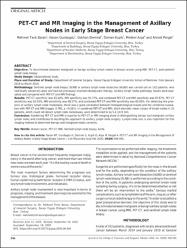| dc.contributor.author | Baran, Mehmet Tarık | |
| dc.contributor.author | Gündoğdu, Hasan | |
| dc.contributor.author | Demiral, Gökhan | |
| dc.contributor.author | Kupik, Osman | |
| dc.contributor.author | Arpa, Medeni | |
| dc.contributor.author | Pergel, Ahmet | |
| dc.date.accessioned | 2020-12-19T19:32:26Z | |
| dc.date.available | 2020-12-19T19:32:26Z | |
| dc.date.issued | 2020 | |
| dc.identifier.citation | Baran, M. T., Gundogdu, H., Demiral, G., Kupik, O., Arpa, M., & Pergel, A. (2020). PET-CT and MR Imaging in the Management of Axillary Nodes in Early Stage Breast Cancer. Journal of the College of Physicians and Surgeons--Pakistan : JCPSP, 30(9), 946–950. https://doi.org/10.29271/jcpsp.2020.09.946 | en_US |
| dc.identifier.issn | 1022-386X | |
| dc.identifier.issn | 1681-7168 | |
| dc.identifier.uri | https://doi.org/10.29271/jcpsp.2020.09.946 | |
| dc.identifier.uri | https://hdl.handle.net/11436/1018 | |
| dc.description | WOS: 000580818800011 | en_US |
| dc.description | PubMed: 33036679 | en_US |
| dc.description.abstract | Objective: To discriminate between malignant or benign axillary lymph nodes in breast cancer using MRI, PET-CT, and sentinel lymph node biopsy. Study Design: Observational study. Place and Duration of Study: Department of General Surgery, Recep Tayyip Erdogan University School of Medicine, from January 2014 to March 2019. Methodology: Sentinel lymph node biopsy (SLNB) or axillary lymph node dissection (ALND) was carried out on 102 patients, who had locally advanced cases and had not previously received neoadjuvant therapy. Axillary lymph nodes pathology results were evaluated and compared with PET-CT and MRI findings. Results: PET-CT specificity was 93.18%, MRI specificity was 93.75%, and combined PET-CT and MRI specificity was 97.67%. PET-CT sensitivity was 81.03%, MRI sensitivity was 68.57%, and combined PET-CT and MRI sensitivity was 83.05%. For detecting the presence of axillary lymph node metastasis, there was a good correlation between histopathological results and the combined evaluation with PET-CT and MRI (kappa: 0.785, p <0.001). in combined PET-CT and MRI, short diamater mean values of lymph nodes in 10 patients, which could not detect lymph node metastases, were determined to be 5.2 +/- 0.9 mm. Conclusion: Combining PET-CT and MRI is superior to PET-CT or MRI imaging alone in distinguishing benign and malignant axillary lymph node; and contributes to deciding the approach to axillary lymph node surgery. Lymph node size is also important for this imaging method to determine benign and malignant nodes correctly. | en_US |
| dc.language.iso | eng | en_US |
| dc.publisher | Coll Physicians & Surgeons Pakistan | en_US |
| dc.rights | info:eu-repo/semantics/openAccess | en_US |
| dc.subject | Breast cancer | en_US |
| dc.subject | PET-CT | en_US |
| dc.subject | MRI | en_US |
| dc.subject | Sentinel lymph node biopsy | en_US |
| dc.subject | Axilla | en_US |
| dc.title | PET-CT and MR imaging in the management of axillary nodes in early stage breast cancer | en_US |
| dc.type | article | en_US |
| dc.contributor.department | RTEÜ, Tıp Fakültesi, Cerrahi Tıp Bilimleri Bölümü | en_US |
| dc.contributor.institutionauthor | Baran, Mehmet Tarık | |
| dc.contributor.institutionauthor | Gündoğdu, Hasan | |
| dc.contributor.institutionauthor | Demiral, Gökhan | |
| dc.contributor.institutionauthor | Kupik, Osman | |
| dc.contributor.institutionauthor | Arpa, Medeni | |
| dc.contributor.institutionauthor | Pergel, Ahmet | |
| dc.identifier.doi | 10.29271/jcpsp.2020.09.946 | |
| dc.identifier.volume | 30 | en_US |
| dc.identifier.issue | 9 | en_US |
| dc.identifier.startpage | 946 | en_US |
| dc.identifier.endpage | 950 | en_US |
| dc.ri.edit | oa | en_US |
| dc.relation.journal | Jcpsp-Journal of the College of Physicians and Surgeons Pakistan | en_US |
| dc.relation.publicationcategory | Makale - Uluslararası Hakemli Dergi - Kurum Öğretim Elemanı | en_US |


















